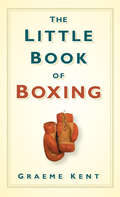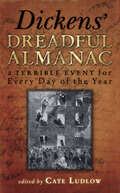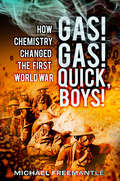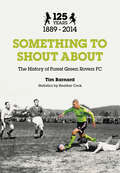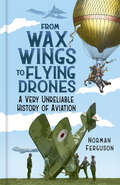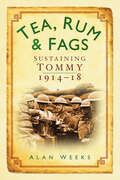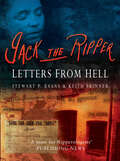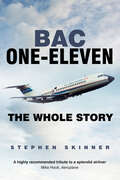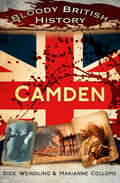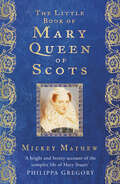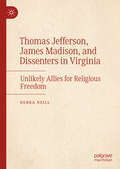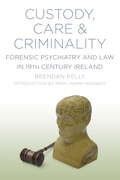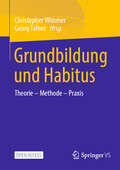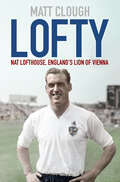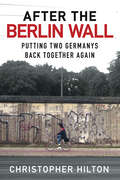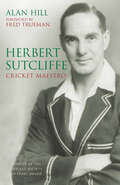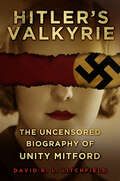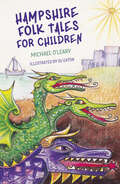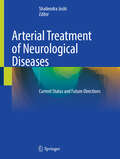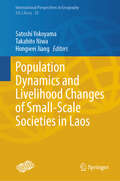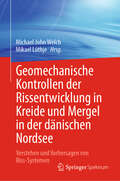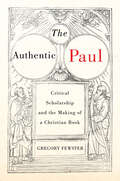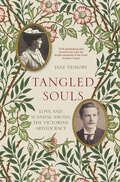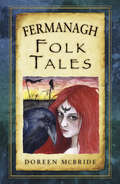- Table View
- List View
The Little Book of Boxing
by Graeme KentBoxing has a long and eventful history and its drama, excitement and humour are covered in this fascinating account of the noble - and sometimes ignoble - art all over the world. From the bare-knuckle days when the Duke of Cumberland callously abandoned his protégé Jack Broughton when the latter could no longer fight on because he was blind, to 1964, when the charismatic Muhammad Ali knocked out Sonny Liston with a ‘phantom punch’ that no one in the audience saw thrown, and the advent in the twenty-first century of the dreaded ‘Beast from the East’, the 7ft tall Russian Nikolai Valuev who powered his inexorable way to the world heavyweight title, this book presents a vivid picture of the sport rightly known as the hardest game. Gallant stands, spectacular ‘dives’ audacious cons and heartbreaking defeats combine to present boxing in all its multi-faceted confusion and glory.
Dickens' Dreadful Almanac: A Terrible Event for Every Day of the Year
by Cate LudlowUnder the headings of 'Narrative of Law and Crime' and 'Narrative of Accident and Disaster' may be found an astonishing catalogue of terrible, grisly and most dreadful Victorian events. Fires and railway disasters abound; shipwrecks, floods and 'horrible affairs' leap from every page. Some of the crimes would surprise even the most ardent fan of crime fiction - it is doubtful that so many cases of such shocking violence and awful ingenuity have been collected together in one volume since. With a terrifying tale for every day of the year, Dickens' Dreadful Almanac will delight lovers of his work everywhere.
Gas! Gas! Quick, Boys: How Chemistry Changed the First World War
by Michael FreemantleGas! Gas! Quick, Boys! reveals for the first time the true extent of how chemistry rather than military strategy determined the shape, duration and outcome of the First World War. Chemistry was not only a destructive instrument of war but also protected troops, and healed the sick and wounded. From bombs to bullets, poison gas to anaesthetics, khaki to cordite, chemistry was truly the alchemy of the First World War. Michael Freemantle explores its dangers and its healing potential, revealing how the arms race was also a race for chemistry to the extent that Germany's thirst for the chemicals needed to make explosives deprived the nation of fertilizers and nearly starved the nation. He answers question such as: What is guncotton? What is lyddite? What is mustard gas? What is phosgene? What is gunmetal? This is a true picture of the horrors of the 'Chemists' War'.
Something to Shout About: The History of Forest Green Rovers FC
by Heather Cook Tim BarnardForest Green Rovers have risen through the ranks to reach the pinnacle of non-League football. As founder members of the Mid-Gloucestershire League in 1894 – the first football league in Gloucestershire outside of Bristol – they have always been forward looking. Their rise has not always been smooth but the ambition of those involved with the club has seen them through and they are now the longest-serving members of the Conference National.This comprehensive history of Forest Green Rovers looks back at the highs and lows of their 125-year existence, right up to the start of the 2014/15 campaign. Taking in the glory of cup wins, promotion campaigns and the drama of several last-minute escapes from relegation– not to mention 1982’s FA Vase win – it will delight Rovers fans of all ages and prove just why the Rovers have something to shout about.
From Wax Wings to Flying Drones: A Very Unreliable History of Aviation
by Norman FergusonWas Keith Harris’s Orville really named after the first-ever flyer? What exactly is a ‘Spitfire’? Why did Richard Branson try to cross the Atlantic in a balloon when he owned an airline? These are the questions that fail to keep proper aeronautical historians awake – but no matter, From Wax Wings to Flying Drones is here to answer them. Chock-full of important stuff like planes, pilots and pioneers such as the Wright brothers, Amelia Earhart and that man off the telly who used to fly on Concorde, this is a book for everyone who’s ever watched a plane in the sky and thought, ‘I wonder what its registration is?’
Tea, Rum and Fags: Sustaining Tommy 1914-1918
by Alan WeeksIt is said that 'an army marches on its stomach', but histories of the First World War usually concentrate on its political and military aspects. The gargantuan task of keeping the British Expeditionary Force fed and watered is often overlooked, yet without adequate provision the soldiers would never have been able to fight. Tommy couldn't get enough tea, rum or fags, yet his commanders sent him bully beef and dog biscuits. But it was amazing how 2 million men did not usually go short of nourishment, although parcels from home, canteens and estaminets had a lot to do with that. Incredibly, Tommy could be in a civilised town supping beer, wine, egg and chps, and a few hours later making do with bully beef in a water-filled trench. Alan Weeks examines how the army got its food and drink and what it was like.
Jack the Ripper: Letters from Hell
by Keith Skinner Stewart P EvansBetween August and November 1888 six women were found murdered and mutilated in London's East End and Aldgate. All were prostitutes; five were found in the street and the sixth in a house. The murders provoked massive interest in the press and dozens of letters quickly appeared, claiming to have been written by the killer. The origin of the name Jack the Ripper itself was a letter, famously written to 'Dear Boss', the head of the Central News Agency.Certain letters have been reproduced or quoted in previous books but Stewart Evans and Keith Skinner are the first to have read and examined every one. This book reproduces and transcibes all the letters, including the 'Dear Boss' correspondence and the horrific letter sent to the chairman of the Whitechapel Vigilance Committee together with a piece of human kidney. The authors relate the letters to the complete story of the Whitechapel murders, tracing the hysteria and misconceptions that dogged both the police and Fleet Street during 1888-9 and providing valuable and revealing insights into the Victorian psyche.For the first time the cases of three people arrested by the police for sending 'Jack the Ripper' letters are explored, including that of Maria Coroner, the attractive 21-year-old Bradford girl. Evans and Skinner also examine the letters of seven suspects, including Dr Roslyn D'Onston Stephenson and Nikaner Benelius. An original and responsible look at a case which has been hackneyed by so many authors, the story of the Ripper letters ends by posing a controversial question: was 'Jack the Ripper' merely a press invention?
BAC One-Eleven: The Whole Story
by Stephen SkinnerIn August 1963, one of the best-selling aircraft of British civil aviation, the BAC One-Eleven, took to the skies for the first time. With an order book for sixty aircraft, more than half were from the United States, which was an unprecedented situation for a British civil aircraft. The first project for the newly formed British Aircraft Corporation, the One-Eleven was wholly designed and built by BAC, and remained in production throughout the entire seventeen-year history of the organisation, performing strongly even when profits were at a low. After flying commercially in Europe for the last time in March 2002, here the One-Eleven is celebrated in style.
Bloody British History: Camden (Bloody British History)
by Dick Weindling Marianne CollomsBlack Death! The horrors of the plague in Camden! My wife is under the floor! The true story of Camden murderer Doctor Crippen! The elephant stampede! Weird accidents and strange events galore! Camden has a dark side to rival that of any London borough. The haunt of highwaymen, its fields also witnessed numerous duels. Crime, poverty and depravity were rife in parts of Holborn until the late nineteenth century. The first murderer to be caught using the transatlantic cable lived in Camden, and the last woman to be hanged shot her lover outside a Hampstead pub. With grave-robbers and grisly graveyard exhumations, eccentric residents and rioting peasants, and featuring tons of weird true events, you’ll never see the borough in the same way again!
The Little Book of Mary Queen of Scots
by Mickey MayhewMary Queen of Scots is perhaps one of the most controversial and divisive monarchs in regal history. Her story reads like a particularly spicy novel, with murder, kidnap, adultery, assassination and execution. To some she is one of the most wronged women in history, a pawn used and abused by her family in the great monarchical marriage game; to others, a murderous adulteress who committed regicide to marry her lover and then spent years in captivity for the crime, endlessly plotting the demise of her cousin, Queen Elizabeth I of England.This book covers the breathtaking scope of her amazing life and examines the immense cultural legacy she left behind, from the Schiller play of the 1800s to The CW teen drama Reign. Temptress, terrorist, or tragic queen, this book will give you the lowdown on one of history’s most misunderstood monarchs.
Thomas Jefferson, James Madison, and Dissenters in Virginia: Unlikely Allies for Religious Freedom
by Debra NeillThis book follows the campaign to disestablish religion in Virginia from 1776 to 1786, when Thomas Jefferson&’s bill to establish religious freedom was passed. This volume seeks to tell the story of Jefferson and James Madison&’s collaboration with Virginia&’s religious dissenters; in doing so, Neill works to understand why religion was disestablished in Virginia. Neill argues that despite their religious differences these unlikely allies shared a basic understanding of what religious freedom meant and how best to secure it: by severing the ties between church and state.
Custody, Care and Criminality: Forensic Psychiatry and Law in 19th Century Ireland
by Brendan Kelly Harry KennedyIn this fundamentally important work, Professor Brendan Kelly explores the background to Irish psychiatry in the nineteenth and early twentieth centuries, charting its progress and development. Using detailed case studies from the original records, the author examines some of the more unusual treatments explored and the history behind them. What emerges is a collection of piercing, untold stories of crime and illness, drama and tragedy. They are filled with a sense of the powerlessness of those detained and the dedicated – and sometimes misguided – enthusiasm of those trying to help. This book sheds important light on the foundations for the treatment of mental illness in Ireland.
Grundbildung und Habitus: Theorie – Methode – Praxis
by Georg Tafner Christopher WimmerDieser Open-Access-Band befasst sich mit dem Zusammenhang von Grundbildung und sozialer Ungleichheit. Er bietet einen Überblick über theoretische, konzeptionelle und methodische Grundlagen und thematisiert habituelle Einflüsse sowie konkrete Praktiken im Bereich der Grundbildung. Die Beiträge sind von namhaften Expert*innen aus Soziologie und Erziehungswissenschaft verfasst und werden durch Praxisberichte ergänzt. Die Besonderheit des Bandes liegt darin, dass soziale Ungleichheit nicht nur als abstrakter Begriff, sondern in Anlehnung an Pierre Bourdieu als gelebte Realität mitsamt ihren relationalen und habituellen Aspekten verstanden wird.
Lofty: Nat Lofthouse, England's Lion of Vienna
by Matt Clough John McGinlayShortlisted for the Telegraph Sports Book Awards Biography of the Year.Nat Lofthouse is a name that rings through the annals of English football history like few others. He was a pivotal figure in one of the true golden ages of the beautiful game, ending his career as the leading goal scorer for both his club and his country, with a reputation as one of the game’s true greats. His retirement coincided almost exactly with the abolition of the maximum wage, and ensured that his name would forever be identified with a time before money flooded the game and changed it inexorably. Lofty explores not only Lofthouse’s life and career in detail never done before, but also delves into his personality and motivation through various key points of his life. Matt Clough uses interviews with those who knew him best and played alongside him, extensive research into newspaper archives and, of course, the words of the man himself to breathe life into one of football’s most legendary figures.
After the Berlin Wall: Putting Two Germanys Back Together Again
by Christopher HiltonOn 7 May 1945, Grand Admiral Donitz, named in Hitler's will as head of state, authorised the unconditional surrender of all German forces to the Allies on the following day. World War II in Europe was at an end. But many of the German people would continue to endure hardships, as both the country and the capital were to be divided between France, the UK and the USA in the west and the USSR in the east. East and West Germany, and East and West Berlin, would remain divided until 1989. By October 1990, however, the two countries were reunited, and the Berlin Reichstag was once again the seat of government. Here, politicians would put East and West back together again, marrying a totalitarian, atheist, communist system with a democratic, Christian, capitalist one. How did this marriage affect the everyday life of ordinary Germans? How did combining two telephone systems, two postal services, hospitals, farm land, property, industry, railways and roads work? How were women's rights, welfare, pensions, trades unions, arts, rents and housing affected? There had been no warning of this marriage and no preparation for it - and no country had ever tried putting two completely opposite systems together before. This is the story of what happened, in the words of the people it happened to - the people's story of an incredible unification.
Herbert Sutcliffe: Cricket Maestro
by Alan Hill Fred TruemanA national hero in his playing days, Herbert Sutcliffe belongs to a select band of all-time cricketing greats. Alan Hill’s award-winning biography of the Yorkshire and England batsman charts his extraordinary transformation from cobbler’s apprentice to urbane gentleman: one of the coolest, most determined and technically accomplished practitioners the game has ever known.Blessed with the looks of a matinee idol, Sutcliffe was a complex, often enigmatic, personality. As a cricketer, he was touched with genius. His career spanned exactly the years between the wars and he performed with distinction in every one of those seasons. He scored 50,138 first-class runs, including 149 centuries, and his remarkable Test average of 60.73 is the highest for an English batsman – higher than those of Hobbs, Hammond or Hutton.Herbert Sutcliffe: Cricket Maestro calls upon the reminiscences of Bob Wyatt, Sir Donald Bradman, Sir Len Hutton and Les Ames among other illustrious contemporaries, to evoke the splendour of Sutcliffe’s achievements for Yorkshire and England, and to bring to life the vivacious story of one of the greatest batsmen ever.
Hitler's Valkyrie: The Uncensored Biography of Unity Mitford
by David R L. LitchfieldEmerging from modern history as a remarkable and much-loved family, the Mitfords have remained largely unrepentant concerning theirs and particularly Unity’s enthusiastic support of Hitler, the Nazis, Oswald Mosley and British fascism. However, having initially encouraged and supported Unity’s affair with Hitler, they subsequently insisted that she had in fact been a rather unintelligent, clumsy lump of a girl, whose virginal relationship with one of the most terrifying dictators of all time was a mere unrequited romantic obsession. As this book will show, nothing could be further from the truth. Following further research and reexamination of the family’s, friends’ and journalists’ often contradictory evidence, plus new information supplied by the author’s own family and friends, Hitler’s Valkyrie will reveal that while Unity was, like Hitler, an extreme fantasist, there was very little of the juvenile romantic about her. On the contrary, she was highly intelligent, free-spirited and athletic. She was also the only Englishwoman who came close to being capable of changing the course of the Second World War. Here David R.L. Litchfield untangles the decades-old web of intrigue surrounding Unity Mitford and one of the most dangerous men of all time, creating a fascinating book of unparalleled importance to the Mitford legacy.
Hampshire Folk Tales for Children
by Michael O'Leary Su EatonIf you love magic and adventure, here is the book for you. In this treasure trove of tales, storyteller Michael O’Leary has collected stories from the Hampshire Downs (which are up), the New Forest (which is old), the copses and coppices, fields and farms, villages, towns and cities of Hampshire. In these stories you will meet dragons, giants, knights, princesses and some vile Vikings – and of course the Liphook fairies. From ‘Once upon a time …’ to ‘Happy ever after’ you will be transported to Hampshire, where even the stones have stories to tell.
Arterial Treatment of Neurological Diseases: Current Status and Future Directions
by Shailendra JoshiDrug delivery by injecting them through arteries poses unique challenges. The first attempts to treat malignant brain tumors by arterial injections were undertaken soon after World War II. Yet, the applications of arterial delivery in treating neurological diseases have not advanced significantly over the last seventy years. Although arterial drug delivery is used to treat several neurological conditions, its applications, other than for localization of brain functions, remain experimental and are unproven in robust scientific studies. Over the last two decades, interventional radiology has significantly advanced by developing catheter-based devices, but arterial drug development has largely been ignored. This book makes the case for arterial drug development. Unless drugs are developed explicitly for arterial injections, the vast potential of arterial treatments of neurological diseases will remain untapped. This multi-author book brings together experienced researchers and clinicians to investigate various applications of arterial drug delivery for treating neurological diseases. It’s an essential resource for various medical subspecialties related to the field and to advance pharmacological and clinical research with this mode of drug delivery.
Population Dynamics and Livelihood Changes of Small-Scale Societies in Laos (International Perspectives in Geography #22)
by Satoshi Yokoyama Takahito Niwa Hongwei JiangThis book examines various trends in small-scale societies in Laos by linking population changes to livelihood changes. The primary research issues addressed in the book are as follows: ・ How are population dynamics and livelihood changes in small-scale societies interrelated? ・ What are the current demographic trends in rural areas of Laos? ・ How are the livelihoods of small-scale societies maintained? ・ How is the rapid population growth common in developing countries managed? In order to investigate these issues in developing countries where statistical data are not well developed, it was necessary to collect information through detailed and distinctive fieldwork. To this end, a multidisciplinary study of geography, cultural anthropology, human ecology, and demography was conducted in three villages in Laos and compiled as an ethnography. The study included a four-generation retrospective survey of population and land use change, a two-year survey of food dairies, and a survey of the spatiotemporal distribution of residents' daily activities using GIS and GPS, etc. The book provides valuable information on the slowdown in the rate of population growth in contemporary rural Laos. Livelihoods, family planning and population migration are explored in the context of the decreasing population growth rate. In addition, the book describes the process of adopting modern contraceptive methods in rural areas, as well as the Lao government's reproductive policies and villagers' responses to them. It also illustrates rural–rural and rural–urban population migration influenced by the government's resettlement policies, which encourages people to move from the highlands to the lowlands.
Geomechanische Kontrollen der Rissentwicklung in Kreide und Mergel in der dänischen Nordsee: Verstehen und Vorhersagen von Riss-Systemen
by Michael John Welch Mikael LüthjeDieses Buch fasst neue Entdeckungen zur Rissbildung in Kreide zusammen. Basierend auf Studien in der dänischen Nordsee zeigt das Buch, wie Beobachtungen von Aufschlussanaloga, Bohrkernen und seismischen Daten genutzt werden können, um die Dichte, Verteilung und Geometrie natürlicher Risse in Kreide und Mergel zu charakterisieren. Laborversuche mit Kreideproben zeigen die Einflussfaktoren auf die geomechanischen Eigenschaften der Kreide und damit auf das Wachstum natürlicher Risse. Schließlich werden verschiedene Modellierungstechniken eingesetzt, um die mechanische Deformation in den Kreide-Strukturen der dänischen Nordsee zu untersuchen und die Rissverteilung sowie -geometrie im Untergrund vorherzusagen. Ein Verständnis der Rissdichte, -verteilung und -geometrie ist entscheidend für die Planung effizienter Strategien zur Fluidextraktion oder -injektion sowie zur CO2-Speicherung. Dieses Buch liefert das notwendige Wissen.
The Authentic Paul: Critical Scholarship and the Making of a Christian Book (Studies in Christianity and Judaism)
by Gregory FewsterWritten in the first century and compiled in the New Testament, the letters of the Apostle Paul have served as a reservoir of divine authority for Christians. Yet from the time of their writing, experts have claimed that some letters were altered or forged. Even after centuries, and generations of critical scholarship, an authentic book of Paul’s letters lacks consensus.The Authentic Paul traces the efforts of scholars, from antiquity to the modern period, who endeavoured to make an authoritative book of Paul’s letters free from textual variation and forgery. Engaging recent trends in the study of religion and book history, it challenges one of philologists’ fundamental assumptions: that authenticity is an inherent property of literature that can be recovered or destroyed. Gregory Fewster draws the philology of Paul, in both its ancient and modern forms, into the wider world of critical philology and its dynamic traditions of practice. Through analyses of ancient papyri and literary texts, early print journals, and critical editions, he shows how the value of authenticity is entangled with the ways that scholars assess Paul’s legitimacy and their own amid dense literary landscapes and intellectual debates.The Authentic Paul illustrates in vibrant detail what it means – in a world full of texts – to make the letters of Paul authentic, and why practices of authentication are always culturally determined.
Tangled Souls: Love and Scandal Among the Victorian Aristocracy
by Jane Dismore'With painstaking skill, Dismore lays bare the double standards of the Souls - a brilliant group who thought themselves superior, in morals and intellect, to the rest of their class' Artemis Cooper'Harry Cust has long needed to emerge from the shadows. A rich tapestry unfolds' Hugo Vickers?Outrageously handsome, witty and clever, Harry Cust was reputed to be one of the great womanisers of the late Victorian era. In 1893, while a Member of Parliament, he caused public scandal by his affair with artist and poet Nina Welby Gregory. When she revealed she was pregnant, horror swept through their circle known as ‘the Souls’, a cultured, mostly aristocratic group of writers, artists and politicians who also rubbed shoulders with luminaries such as Oscar Wilde and H. G. Wells.With the unconventional Margot Tennant and philosopher-statesman Arthur Balfour at their centre, the dazzling Souls eschewed the formalities of upper-class etiquette, valuing conversation and clever games above gambling and racing. Talented and glamorous women such as Violet Granby and Ettie Grenfell joined rising politicians George Curzon and George Wyndham at grand country houses to talk, play and flirt.Passions raged behind their courtly code. Married Souls discreetly bore their lovers’ children – and public figures got away with much worse – yet bachelor Harry’s seduction of a single woman of the same class broke the rules. For the rest of their lives, Harry and Nina would fight to rebuild their reputations and maintain the marriage they were pressurised to enter.In Tangled Souls, acclaimed biographer Jane Dismore tells the tumultuous story of the romance which threatened to tear apart this distinguished group of friends, revealing pre-war society at its most colourful and most conflicted.
Fermanagh Folk Tales
by Doreen McBrideFermanagh's culture, heritage, characters and stories set it apart from the rest of the world. Every mountain, tree, lake, stream, rock, stone and character tells a tale. There are the strange stories of mythical creatures, such as the Shining Folk that lurk under the surface of Lough Erne, and the fairies that taught the unruly wee Meg Barnileg a lesson. There are spooky tales of the Cooneen poltergeist that haunted the Murphy family and the ghost of Belleek Pottery. And there are the ‘pants’, or tall tales, that the locals love to retell, such as the stories about ‘educated’ Irish pigs who understood three languages, talking horses or the pike who went ‘fishing’ for squirrels. All these stories and more are featured in this unique collection which will take you deep into the heart of this historic county.
